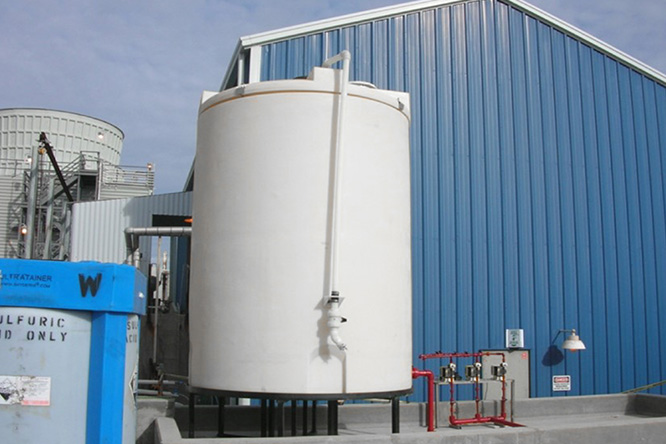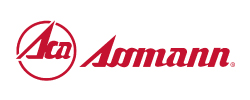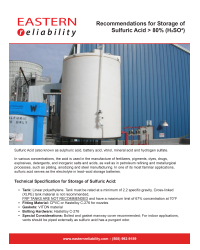Recommendations for Storage of >80% Sulfuric Acid (H2SO4)
Sulfuric Acid (also known as sulphuric acid, battery acid, vitriol, mineral acid and hydrogen sulfate).
In various concentrations, the acid is used in the manufacture of fertilizers, pigments, dyes, drugs, explosives, detergents, and inorganic salts and acids, as well as in petroleum refining and metallurgical processes, such as plating, anodizing and steel manufacturing. In one of its most familiar applications, sulfuric acid serves as the electrolyte in lead-acid storage batteries.

Technical Specification for Storage of Sulfuric Acid:
Linear polyethylene with the tank rated at a minimum of 2.2 specific gravity. Fiberglass (fiber reinforced plastic or FRP) tanks by customer preference, due to footprint constraints, or larger storage volume requirements.
- Tank:
Linear polyethylene tank must be rated at a minimum of 2.2 specific gravity. Cross-linked (XLPE) tank material is not recommended for direct contact with highly concentrated Sulfuric Acid. FRP TANKS ARE NOT RECOMMENDED and have a maximum limit of 67% concentration at 70°F. - Fitting Material:
CPVC or Hastelloy C-276 for nozzles - Gaskets:
VITON material - Bolting Hardware:
Hastelloy C-276 - Special Considerations:
Bolted and gasket manway cover recommended; For indoor applications, vents should be piped externally as sulfuric acid has a pungent odor
Secondary Containment
All end users should check local regulations to meet secondary containment requirements. Containment must be adequate in capacity and suitable for sulfuric acid. By accepting the delivery of the tank, the customer accepts full responsibility for providing appropriate and adequate containment for the stored material. Eastern Reliability offers a variety of secondary containment basins.
Connections
All connections below liquid level must prevent chemical from contacting tank wall cross section. Bulkhead style connections can be used on tanks 2,000 gallons and below. Tanks above 2,000 gallons sidewall connections should be Hastelloy C-276 construction (flange style fittings are not recommended). Sidewall connections should be installed a minimum of 7" above the tank floor. Internal siphon drains can be used if required. Sidewall connections should be kept to a minimum amount and should be placed no closer than 22° apart. Whenever possible, sidewall connections should not be greater than 3". There are no restrictions on dome fittings.
Sidewall connections should be installed a minimum of 7" above the tank floor. Internal siphon drains can be used if required. Sidewall connections should be kept to a minimum amount and should be placed no closer than 22° apart. Whenever possible, sidewall connections should not be greater than 3". There are no restrictions on dome fittings.
Flexible Hoses or Expansion Joints (not required for FRP tanks)
Flexible hoses or expansion joints must be used on all lower 1/2 sidewall connections. A lightweight isolation valve is permitted prior to the flexible joint. Nipple and valve weight must not exceed 8 lbs. All piping must be supported independent of tank. Pipe supports must be installed after the flexible joint to allow the tank to expand and contract under normal service conditions. Polyethylene tanks expand and contract both laterally and vertically. The expansion hose or joint must accommodate for this expansion.
The tank must maintain atmospheric pressure. Vents must be sized for a minimum of two times the largest inlet or outlet port for pneumatically filled tanks. The pump fill tank’s vent should be a minimum of one and a half times larger than the largest fill or discharge point. Tanks vented through a drying system, the vent size cannot be reduced passing through the dryer. Adequate venting must always be maintained. Dryer media needs to be checked per manufacturer’s instructions. Additional pressure vacuum vents should be installed to ensure proper tank venting. Under no circumstances should tank be placed under pressure or vacuum conditions.
Sulfuric Acid
Sulfuric Acid must not exceed 100°F at delivery or during storage. When practical, tanks should be kept from direct sunlight to avoid excessive heat.
Excessive heat will degrade the chemical and will accelerate chemical reaction with tank materials. Heat will also cause additional off gassing and additional odors. HCl storage sometimes requires an accompanying Sodium hydroxide (NaOH) scrubber tank for vent odor scrubbing to prevent excessive odors.
Delivery
Deliveries must be regulated. Sulfuric acid is a heavy material weighing up to or exceeding 16 lbs/gallon. Bulk storage tanks above 4,200 gallons are rarely utilized due to transportation constraints carrying such a heavy chemical. Maximum delivery pressures must not exceed 12 PSI. Ideally, acid fumes should be vented back into delivery truck during offloading of chemical. If drying system is being used, be sure that airflow through system is adequate to keep up with delivery pressure and airline surge. Under no circumstances should tank be placed under pressure or vacuum conditions.


